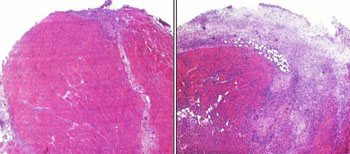Biomaterial Scaffolds Boost Interleukin Production to Promote Wound Healing
By LabMedica International staff writers
Posted on 29 Apr 2016
The improved wound healing promoted by use of "biomaterial" scaffolds was shown to be due to activation of the immune system's T helper II pathway with a subsequent increase in production of interleukins.Posted on 29 Apr 2016
Biomaterial scaffolds derived from cardiac muscle and bone extracellular matrix components help to guide regenerating tissue. Investigators at Johns Hopkins University (Baltimore, MD, USA) tested how such biomaterial scaffolds interact with the immune system in damaged tissue to promote repair.

Image: A cross-section of injured mouse muscle tissue, with healthy tissue in pink and scar tissue shown in purple. Both mice genetically lack T-cells; the mouse on the left was injected with T-cells that became type II helper T-cells and aided healing (Photo courtesy of Dr. Kenneth Estrellas, Johns Hopkins University).
They reported in the April 15, 2016, issue of the journal Science that scaffolds induced a pro-regenerative response, characterized by an mTOR/Rictor-dependent T helper II pathway that guided interleukin-4 (IL4) – dependent macrophage polarization, which was critical for functional muscle recovery. Mice that had been genetically engineered to lack T-cells did not activate interleukin production or heal as well as normal mice.
"In previous research, we have seen different immune system responses to the same biomaterial implanted in different tissues or environments, and that got us interested in how biomaterials might stimulate the immune system to promote regeneration," said senior author Dr. Jennifer Elisseeff, professor of ophthalmology and biomedical engineering at Johns Hopkins University. "We still have a lot to learn, but this study is a step toward designing materials to elicit a beneficial immune response."
Related Links:
Johns Hopkins University













